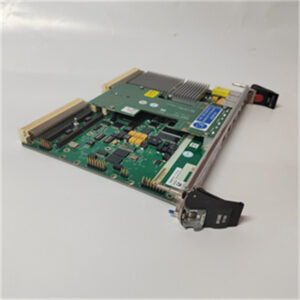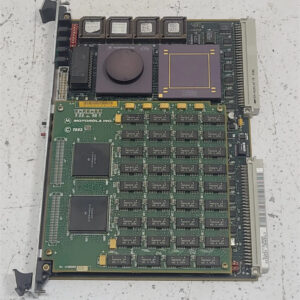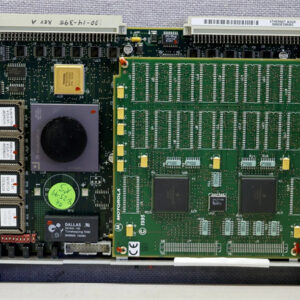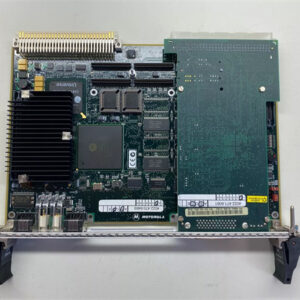Description
Motorola MVME – 147A Product Description
Detailed parameter table
| Parameter name | Parameter value |
|---|---|
| Product model | MVME – 147A |
| Manufacturer | Motorola |
| Product category | Embedded single – board computer module |
| Processor | MC68030 microprocessor, typically running at 33 MHz |
| Memory | 4MB of on – board DRAM, expandable up to 32MB |
| Floating – point coprocessor | Optional support for MC68882 |
| Serial ports | 4 RS – 232 serial ports with buffering capabilities |
| Communication interfaces | SCSI interface for storage connection, no built – in Ethernet (in some basic configurations) |
| VMEbus interface | Full VMEbus master and slave functionality, supports A32/D32 addressing modes |
| Operating temperature range | 0°C – 60°C |
| Storage temperature range | – 40°C – 85°C |
| Dimensions | 160mm x 233.35mm (6.3 in x 9.2 in) |
| Weight | Approximately 0.8kg |
| Power supply requirements | +5V DC ± 5%, draws up to 3.5A under full load |
| Watchdog timer | Integrated watchdog timer for system reliability |
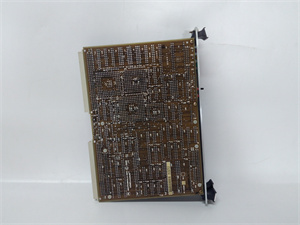
MVME-147A
Product introduction
The Motorola MVME – 147A is a highly reliable embedded single – board computer module from Motorola, a brand with a long – standing reputation in industrial technology. Positioned as a key component for industrial control and automation systems, it offers robust processing capabilities and flexible integration options.
At its core, the MVME – 147A features an MC68030 microprocessor, often clocked at 33 MHz, providing sufficient computing power for a wide range of industrial applications. With a base 4MB of DRAM that can be expanded up to 32MB, it can handle data – intensive tasks, such as real – time monitoring and control. The option to add an MC68882 floating – point coprocessor enables precise numerical calculations, making it suitable for applications that demand high – accuracy processing. Equipped with 4 RS – 232 serial ports and an SCSI interface, the MVME – 147A can connect to various sensors, actuators, and storage devices, allowing it to play a central role in managing and coordinating industrial processes within automation ecosystems.
Core advantages and technical highlights
Efficient processing performance
The MVME – 147A‘s MC68030 microprocessor ensures efficient data processing. In industrial automation, where quick responses to sensor inputs are crucial, this module can rapidly execute control algorithms. For example, in a manufacturing plant’s quality inspection system, it can process data from multiple sensors in real – time to detect product defects promptly. The ability to expand memory up to 32MB allows it to handle increasing data volumes as industrial systems grow in complexity, ensuring long – term usability without major hardware overhauls. The optional floating – point coprocessor further enhances its performance in applications that require complex mathematical operations, such as in scientific research – related industrial processes.
Versatile connectivity options
With 4 RS – 232 serial ports, the MVME – 147A can easily interface with legacy industrial devices, such as older sensors and controllers. The SCSI interface provides high – speed data transfer to and from storage devices, enabling efficient data storage and retrieval. While some basic configurations may lack an Ethernet interface, in setups where network connectivity is added, it can integrate with other systems for remote monitoring and control. This versatility in connectivity makes it adaptable to a wide variety of industrial environments, whether it’s a small – scale factory or a large – scale industrial complex.
Reliable and stable operation
Built to withstand the rigors of industrial settings, the MVME – 147A operates reliably within a temperature range of 0°C – 60°C and can be stored safely between – 40°C – 85°C. Its integrated watchdog timer monitors the system’s operation and can automatically reset the module in case of software or hardware malfunctions, minimizing downtime. The robust construction and high – quality components used in its manufacturing ensure consistent performance over time, making it a trusted choice for industrial applications where reliability is paramount.
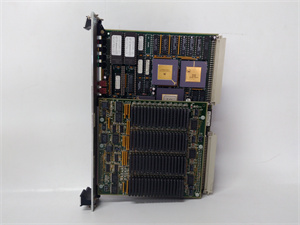
MVME-147A
Typical application scenarios
Factory automation
In factory settings, the Motorola MVME – 147A can be used to control automated production lines. It can receive data from sensors that monitor the position, speed, and quality of products as they move along the conveyor belts. Based on this data, it sends control signals to robotic arms, motors, and other actuators to adjust the production process in real – time. For instance, in a food processing factory, it can regulate the filling levels of packaging machines, ensuring consistent product quality and minimizing waste. It can also communicate with human – machine interfaces (HMIs) to provide operators with real – time status updates and allow for manual overrides when necessary.
Industrial monitoring and control systems
In large – scale industrial plants, such as power generation facilities or chemical plants, the MVME – 147A can be part of monitoring and control systems. It interfaces with sensors that measure critical parameters like temperature, pressure, and flow rates in pipes and reactors. By continuously analyzing this data, it can detect anomalies and trigger alarms or initiate corrective actions. For example, in a power plant, it can monitor the performance of turbines and generators, adjusting their operation to optimize power output and prevent equipment failures. Its ability to handle multiple data streams and execute complex control algorithms makes it an essential component in ensuring the safe and efficient operation of industrial processes.
Test and measurement equipment
In the field of test and measurement, the MVME – 147A can be used in equipment that requires precise data processing and control. It can interface with various test sensors and instruments, collect data, and perform calculations to analyze the test results. For example, in a laboratory setting where electronic components are being tested for performance, the MVME – 147A can control the test setup, acquire data from measurement devices, and determine if the components meet the required specifications. Its reliable performance and processing capabilities make it suitable for applications where accuracy and repeatability are crucial.
Related model recommendations
MVME147S
The MVME147S is closely related to the MVME – 147A. It typically offers enhanced features, such as an Ethernet interface in some versions, which the basic MVME – 147A may lack. This makes the MVME147S more suitable for applications that require network – based communication, like remote monitoring and integration with modern industrial IoT systems. While sharing a similar processor and memory expansion capabilities, the MVME147S provides additional connectivity options for more advanced industrial setups.
MVME147SRF
The MVME147SRF also belongs to the same product family. It may have specific optimizations for certain industrial environments. Similar to the MVME – 147A, it has an MC68030 processor, but it might offer different memory configurations or additional features related to serial communication. In some cases, it could be better suited for applications that rely heavily on serial – based device connectivity, such as in older industrial plants with legacy equipment.
MVME147 – 013A
The MVME147 – 013A can be seen as an upgrade option for the MVME – 147A. It usually provides increased memory capacity out – of – the – box, allowing for more efficient handling of larger data sets. This model is ideal for applications that have high data – storage and processing requirements, such as high – resolution image processing in industrial inspection systems or complex data analytics in manufacturing operations.
MVME162 – 012
The MVME162 – 012 uses a different processor architecture (MPC7457) compared to the MVME – 147A. It offers significantly higher processing performance and is suitable for applications that demand extreme computing power, like high – speed data analytics in large – scale industrial networks. While the MVME – 147A is a reliable choice for standard industrial control tasks, the MVME162 – 012 serves as an alternative for more advanced and data – intensive applications.
MVME5100
The MVME5100 is part of a more modern product line. It features advanced interfaces, such as Gigabit Ethernet, PCI – X, and USB, along with a more powerful integrated processor. It represents a major upgrade path for applications that outgrow the capabilities of the MVME – 147A. The MVME5100 is well – suited for integrating with emerging industrial technologies, such as Industry 4.0 initiatives, where high – speed data communication and advanced processing are essential.
Installation, commissioning and maintenance instructions
Installation preparation
Before installing the Motorola MVME – 147A, ensure the installation area is clean, dry, and free from excessive dust. The ambient temperature should be within the 0°C – 60°C operating range. Use anti – static wrist straps and appropriate tools to handle the module, as static electricity can damage its sensitive components. When installing in a VMEbus system, make sure the VMEbus backplane is properly configured and powered off. Carefully align the MVME – 147A with the VMEbus slot and insert it gently but firmly to ensure a secure connection. Connect the power supply cables according to the provided wiring diagram, double – checking that the +5V DC power is within the ± 5% tolerance range. Also, ensure that all external devices connected via serial ports or the SCSI interface are properly configured and powered.
Maintenance suggestions
Regularly inspect the MVME – 147A for physical damage, such as bent pins or signs of overheating. Clean the module using a static – free, dry cloth to remove dust that can affect its performance. Periodically run diagnostic software to test the functionality of the serial ports, SCSI interface, and other components. If any issues arise, start by checking the physical connections and power supply. In case of a malfunction, refer to the Motorola technical documentation for troubleshooting steps. When replacing components, such as memory modules or connectors, always use genuine Motorola parts to maintain the module’s reliability and compatibility. Keep a record of all maintenance activities, including the date, actions taken, and any issues resolved, for future reference.
Service and guarantee commitment
Motorola stands firmly behind the Motorola MVME – 147A. Every module undergoes strict quality control during the manufacturing process to meet international standards. Motorola offers a comprehensive warranty period, covering any manufacturing defects that may occur. In the event of issues within the warranty period, Motorola’s global technical support team is readily available. They can provide detailed guidance on installation, efficient troubleshooting, and maintenance. Motorola also invests continuously in research and development, and may release software updates to enhance the functionality and compatibility of the MVME – 147A. The company provides extensive documentation, including user manuals and technical guides, to assist users in maximizing the potential of the module. This commitment reflects Motorola’s confidence in the product’s quality and its dedication to customer satisfaction in the industrial control field.
We've got you covered
We give you access to a global supply of automation parts at your fingertips, ensuring that manufacturers around the world can avoid unnecessary downtime and continue to do what they do best – making our world possible.
Full 12-month warranty on all components
Dedicated after-sales support
Same-day dispatch on 1000s of parts
All units are fully tested
Continue Searching
We're here when you need us
What happens next?
- 1. Email confirmation
You will get an email confirming that we have received your enquiry. - 2. Dedicated Account Manager
One of our team will be in touch to confirm your part(s) specification and condition. - 3. Your quote
You will receive a comprehensive quote tailored to your specific needs.
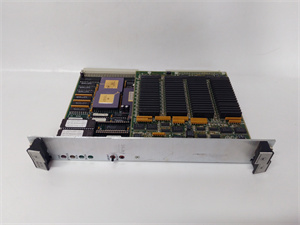
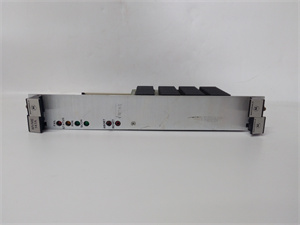
 Full 12-month warranty
Full 12-month warranty Available for dispatch immediately
Available for dispatch immediately We deliver worldwide
We deliver worldwide Full 12-month warranty on all components
Full 12-month warranty on all components